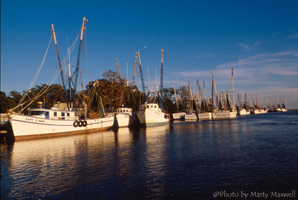| page last updated |
 |
River Tour | Estuary | Salt Marsh | |
| What is an Estuary? > Climate > Geology > Surface Water > Ground Water > Aquatic Habitat > Upland Habitat > Ecological Processes > Animals and Plants > Socioeconomic Values > Human Impacts and Pollution > Where does Your water come from? > Management Issues > Protecting YOUR Watershed | ||
|
K-12
Students Site
|
||
| Human Impacts > Chemical and Waste Pollution > Sediment Pollution > Disease Pollution | ||||||
|
Factories and power plants produce chemicals and other waste that need to be disposed of. Sometimes, companies do not dispose of their wastes properly. Industries are built next to rivers so that wastes can be flushed right into the river. Waste may be stored, buried, or just dumped on the ground. Eventually these chemicals and waste seep into our groundwater. Cars and factories pollute the air with smoke and exhaust. Some of the harmful gases they release include sulfur dioxide (SO2) and nitrogen dioxide (NO2). These gases mix with water vapor in the air and fall back to earth as acid rain. Acid rain contaminates everything it falls on: soil, water, and plants. The chemical composition of rivers and lakes may change and become toxic to plants and animals. Acid rain is so harmful it even damages the buildings it falls on! Agriculture creates pollution, too. Pesticides (chemicals that kill insects and rodents) and herbicides (chemicals that kill plants) applied to cropland wash off during rains. They are carried by rainwater to streams and rivers. Like all chemicals in water, they also may seep through the soil into groundwater. You and I pollute every time we throw something out. All the wrappers and packaging from everything we use ends up in landfills. Human garbage includes plastics, Styrofoam, paper dyed with chemicals, paint cans, rusty cars and lots more. Through time, rainwater wears away at our garbage sitting in landfills. Eventually these chemicals and waste seep into our groundwater. Chemicals that reach our drinking water can make us sick. Contaminated water can lead to headaches, dizziness, liver problems, and cancer. Very small organisms that live in estuaries, such as algae and bacteria, may not be able to survive in contaminated water. If they do not survive, the organisms that eat them cannot survive (and the organisms that eat those organisms cannot survive, etc.). Larger organisms, such as fish and shrimp, may be able to survive in contaminated water. However, pollution may affect their ability to reproduce. If animals cannot reproduce, their populations may go extinct. Eating contaminated animals may make humans and other animals sick. Chemicals become more concentrated as they move up a food chain. Economic problems occur when animals we like to eat are not safe to eat. People that fish and harvest oysters and shrimp may go out of business. It is estimated that two-thirds (2/3) of all commercial fish spend some part of their life cycle in an estuary. |
||||||
 |
||||||
|
Shimp boats at Darien, GA on the Altamaha R. click on picture for a larger view |
||||||
|
Pollution is a difficult problem because it is produced as a by-product of goods and services that are valuable to us. The good news is that there are many things we each can do (yes, YOU!) to help solve our problems. To learn more about reducing your impact on the environment, see Protecting our watershed: What YOU can do to help. Remember,
we all live downstream! In addition to local pollution, our water contains
pollutants from people living upstream. And, of course, our pollution
affects the water of people living downstream from us. |
||||||